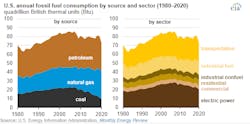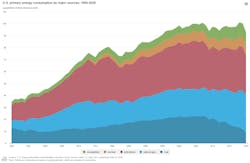By John Mullen, Director of Technical Services, IAPMO
“Every built environment can go electric all at once and there will be no more carbon emissions” is a claim we have all heard quite a bit lately. While true that switching from fossil fuels to electricity as a source of energy will greatly reduce pollution, doing so safely would require a tremendous amount of research and effort, along with industry guidance.
Here in the United States, we have taken huge leaps to accelerate our green energy generation and no one wants to throw unnecessary speed bumps in front of that effort. Resiliency and sustainability are not just buzz words you hear paired with terms like decarbonization; these are prerequisites for generating meaningful change for our future generations and making certain our buildings are ready for whatever gets thrown their way.
America's Grid is Feeling the Stress
Continuing blackouts and brownouts in densely populated urban and suburban areas prove our existing grid is not ready for this all-at-once approach. The literal flicking of a switch from fossil fuels to electric in the built environment could backfire due to increased electric loads, exacerbating an already devastating and life-threatening problem brought to you by our nation’s stressed-out grid system.
Over the past few years, energy production in America has begun to look only slightly more balanced in its approach, with roughly one-third being sourced from natural gas, one-third from petroleum and the last third being an accumulation of nuclear, coal and renewables. The eventual replacement of petroleum with more renewable options like nuclear or green hydrogen will change these charted figures for the better. Inevitably, the supplementation of H2 in certain applications will lead to the reduction of natural gas harvesting. By creating blends of green hydrogen and natural gas that are ready to be used today with our current infrastructure, we can recalibrate our efforts and prepare for an even more sustainable future.
Buildings, both commercial and residential, have been changing rapidly as it relates to the use and generation of power. Specifically, with building energy independence, grid systems will experience smaller load demand, allowing utility companies to pivot and consider more sustainable modalities to power generation at more complex and critical spaces. If we see more energy independence from renewables in the commercial and residential spaces, our entire energy system in America will look and function differently. There is the likelihood for a very disruptive role reversal, shifting traditional energy consumers into energy producers.
Buildings Need Redundancy for Resiliency
It is more than likely that in the future, these energy-independent buildings could form modern-day microgrids. These microgrids could exist throughout different regions, feeding back electricity to nearby cities and lessening the utility companies’ need for fossil fuel production, in turn lowering emissions caused by the producer.
While the use and production of fossil fuels generally is something we all agree to transition from as a nation, we must consider other sources of energy for resiliency and redundancy. When we remove alternative fuel sources from the conversation in the name of reducing carbon emissions, we fail to provide system redundancy in the face of catastrophic events. It is a “throwing the baby out with the bathwater” scenario.
In the interim, blended fuel sources like H2 are a seemingly viable option for the transition in these types of buildings. In many cases, concentrated levels of hydrogen and natural gas allow existing fuel gas piping to be utilized. On-site production of green hydrogen gas for operating high-energy production equipment in commercial and industrial settings could sharply offset the amount of fossil fuels being utilized for plant operations. This site-driven energy independence would be a huge step away from fossil fuel reliance and would ease the grid stress these building types would typically inflict.
When on-site storage and compression technology is combined with on-site production, we may see an apex in our transition. Energy storage remains an issue in most applications, and for now we will continue to rely on internal combustion engines (ICE) operated by fuel gas in our most critical environments when the lights go out.
Residential Makes it Look Easy
Thanks to innovation and partnerships we experience from the solar and battery industry, green energy homes are giving utility companies a rest. With today’s technologies, residential environments can be sole producers of their own electricity thanks to solar accessibility and subsidized incentives. Homes in most urban, suburban and rural areas can produce and store modest amounts of electricity in a safe way, even selling unused energy via net metering back to the grid. These types of homes are the model in some cases; they create what they use and what they do not, they give.
I am from New York, and I know firsthand that this region of the country has made tremendous progress in its transition to clean natural gas over the past few decades. Suburban areas like Long Island went from leaky in-ground oil tanks and unsightly and dangerous propane vessels strapped to the homes to connected sources of natural gas delivered directly from underground piping networks. Unfortunately, there have been many bumps in that road as it relates to adequate production, leading to localized gas moratoriums, stifling new construction and in turn limiting environmentally conscious options for homeowners.
The Northeast knows very well what it is like to not have electricity for durations of time thanks to unfortunate events like Superstorm Sandy and other historic blackouts. The redundancy that fuel sources have provided this region’s most critical environments has taught us that alternative energy sources are vital to keeping society operating safely. Having access to fuel sources during these events has provided life-sustaining solace for people who otherwise might not have had heat, hot water, or temporary electricity during these kinds of catastrophes.
Heating equipment for homes has seen a bit of a renaissance due to these ever-changing conversations. Electronic equipment like boilers and water heaters, although not as efficient and effective in recovery as fuel, has been greatly improved over the past few years. The mass introduction of heat pumps and geothermal presents amazing options when paired with green sources of energy generation, and they are competing for the void fuel is leaving in the residential space.
There is still so much more innovation to be seen, and although we tend to think we have solutions, our problems will forever continue to change. With radical weather patterns and climate change we are constantly reminded that we must remain malleable and able to pivot with balanced hybrid approaches that shine a spotlight on resiliency by renewables.
Together We Can Find a Way
We have our work cut out for us in the plumbing industry as we adapt to these new applications and alternative fuel sources coming down the pike. We must not forget the fundamentals of what we do, and that is to provide safe working pipe systems for the people, wherever they are and whatever the medium.
That is why the folks at the International Association of Plumbing and Mechanical Officials (IAPMO) are working each day to create cutting-edge innovation task groups, specifically designed to go head on with these new approaches and work to create actionable guidance documents that can be adopted into code for the safety of the public.
IAPMO is slated to kick off its Hydrogen Fuel Gas Piping Task Group this summer, and your effort and willingness to volunteer will make a lasting impact on the safe implementation of modern fuel gas piping systems. The group plans to tackle topics such as acceptable piping materials for hydrogen blends, inspection processes, leak detection and other piping and appurtenances requirements.
If you are interested in joining us, please check out iapmo.org for more information.
John Mullen is director of Technical Services at IAPMO, where he engages with industry professionals throughout the world, bringing the best and brightest minds together to work on safety initiatives and code-related topics. For nearly two decades he has offered his unique leadership experience and vision to help develop more intelligent and sustainable systems, running operations for large union plumbing and mechanical outfits.





